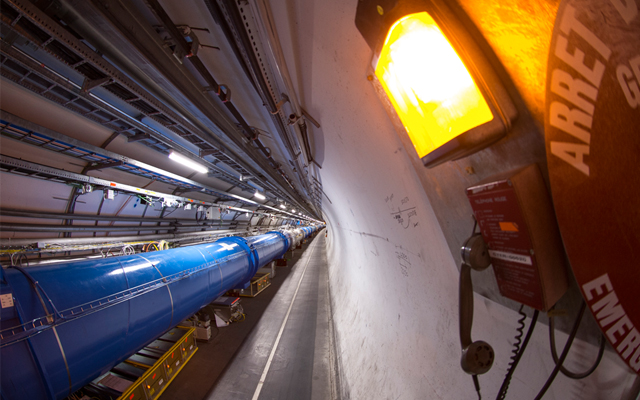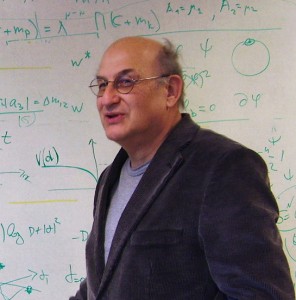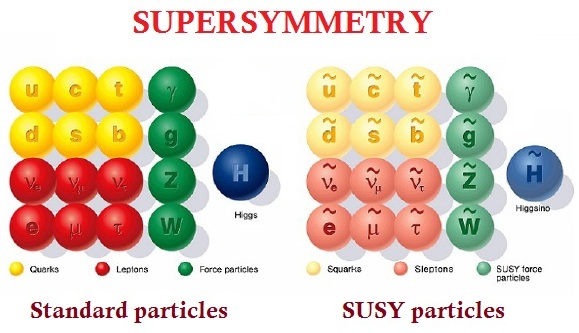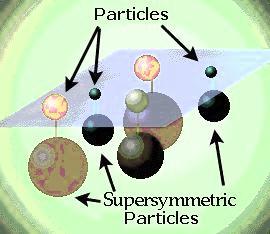Supersymmetry is not confirmed by experiments, and physicists are looking for new ideas.
- Transfer

In experiments at the Large Hadron Collider, a 26-kilometer circular tunnel at the CERN Laboratory in Switzerland, where high-energy protons collide, no hints of "new physics" outside the Standard Model have been received.
Mikhail Shifman , a young Moscow theoretical physicist in 1982, was struck by the elegance of a new theory called supersymmetry, which tried to include well-known elementary particles in a more complete catalog of particles of the Universe.
“My works of that time are just glowing with enthusiasm,” says Shifman, a 63-year-old professor at the University of Minnesota. Over the decades, he and thousands of other physicists have developed a hypothesis of supersymmetry in the belief that experiments will confirm it. “But nature doesn't need it,” he says. - At least, in a simple original form. "
Since the largest collider in the world could not detect the particles that should exist according to this theory, Shifman joins the choir of researchers, urging his colleagues to change course.

Mikhail Shifman
In an essay published in October 2012, Shifman urged his colleagues to abandon the path of “elaborate elaborately pretentious and aesthetically unattractive modifications” of supersymmetry, conducted to explain the fact that simpler versions of the theory are not confirmed by tests. He writes that the time has come "to start thinking and developing new ideas."
But the material for the work is not enough. So far, no hint of a “new physics” outside of the Standard Model — the accepted set of equations describing the known elementary particles — has emerged neither in experiments at the LHC or anywhere else. (The recently discovered Higgs boson was predicted by the Standard Model). The latest proton collision tests in Kyoto, Japan, have eliminated another large class of supersymmetric models, and other theories of "new physics", since they did not find anything unusual in the decaying particles.
“Of course, this is disappointing,” says Shiffman. - We are not gods, we are not prophets. In the absence of hints on the direction of motion in the experimental data, how can you guess about something happening in nature? "
Younger physicists who study particles face a difficult choice: follow the path that their teachers have trodden for decades and invent even more sophisticated versions of supersymmetry, or go their own way, without any direction from any data.
“This is a difficult question that most of us are trying not to answer yet,” said Adam Falkovsky, a specialist in particle physics from the University Paris-South XI in Orsay, France, who works at CERN. On the blog post about the Japanese tests, Falkovsky jokes that it is time to look for work in neurology.
“This is not encouraging,” says Stephen Martin, a specialist in high energy physics from the University of Northern Illinois, who works on supersymmetry, or briefly, SUSY. - I certainly do not believe that SUSY should be correct. I just can't think of anything better. ”
Supersymmetry dominated particle physics for decades, and excluded almost all alternative physical theories that went beyond the SM.
"It is difficult to overestimate the contribution of physicists to SUSY over the past 20-30 years, so its failure will have a strong influence on our field," said Peter Woit, a specialist in particle physics and a mathematician at Columbia University.
The theory is attractive for three reasons. It predicts the existence of particles, of which “dark matter”, an invisible substance that penetrates the edges of galaxies, can consist. It combines three fundamental interactions at high energies. And the biggest advantage is that it solves the riddle of physics called “the problem of gauge hierarchy”.
The enigma is related to the disproportion of gravity and the weak nuclear interaction, which is 100 million trillion trillion (10 32) times stronger, and acts on a much smaller scale, controlling the interaction within the atomic nucleus. The particles transporting the weak interaction, W and Z-bosons, receive a mass from the Higgs field, the field of energy that permeates space. But it is not clear why the energy of the Higgs field, and accordingly the masses of the W and Z-bosons, is so small. Since other particles are associated with the Higgs field, their energies must flow into it at the moment of quantum fluctuations. This should greatly increase the energy of the Higgs field, making the W and Z bosons more massive and making the weak interaction weaken to the level of gravity.

Supersymmetry solves the hierarchy problem by assuming the existence of a twin twin-partner for each elementary particle. According to the theory, fermions that make up matter have boson superpartners that transfer interactions, and existing bosons have fermion superpartners. Since the types of particles and their superpartners are opposite, the contributions of their energy to the Higgs field have opposite signs — one increases it, the second decreases. The contributions of the pairs are mutually annihilating, and no catastrophes occur. And as a bonus, one of the undiscovered superpartners may be part of dark matter.
“Supersymmetry is beautiful, and in physics we allow such beauty and aesthetics to lead us in the direction in which truth can be,” says Brian Greene, a theoretical physicist at Columbia University.
Over time, since the superpartners did not appear, supersymmetry became less beautiful. According to popular models, in order to avoid detection, superpartner particles have to be heavier than their counterparts, and instead of symmetry some kind of curved mirror appears. Physicists have put forward a huge amount of ideas about how symmetry can be broken, and have generated thousands of versions of supersymmetry.

But supersymmetry breaking is a new problem. “The harder it is to make superpartners compared to existing particles, the worse the mutual exclusion of their actions works,” explains Martin.
Most particle physicists in the 1980s believed that superpartners would be only slightly heavier than known particles. But at Tevatron, an accelerator at Fermilab, now suspended from work, nothing of the kind was found. And while the LHC is testing ever higher energies without finding a trace of supersymmetric particles, some physicists say the theory is dead. “I think the LHC was the last straw,” said Voit.
Currently, most working versions of supersymmetry predict so heavy superpartners that they would overpower the effects of their light twins if it were not for the precisely tuned mutual destruction of the effects between the various superpartners. But the fine adjustment intended to neutralize the problems of the theory and solve the problem of the hierarchy does not please many. “This shows that we may need to step back and think about the problems for the solution of which SUSY was invented,” said Shifman.
Some theorists are bursting further, and argue that, despite the beauty of the original theory, there can be an ugly combination of superpartner particles and tweaks in nature. “I think the mistake will be concentrating on popular versions of supersymmetry,” said Matt Strassler, a physicist in the field of elementary particles from Rutgers University. "Popularity contests are an unreliable indicator of truth."

Adam Falkovsky
In the less popular models of SUSY, the lightest of the superpartners are looking for the LHC. In other models, superpartners are not heavier than existing particles, but less stable, which makes them harder to detect. These theories will continue to be tested on the LHC after the upgrade.
If nothing new is found - and they say something about such a development as a “nightmarish scenario” - the same gaps remain to physicists that confused the whole picture of the Universe three decades ago, before they were neatly closed by supersymmetry. And in the absence of a higher energy collider, says Falkowski, this area will slowly degrade. "The number of jobs in particle physics will fall, and particle physicists will die out naturally."
Green is more optimistic. “Science is a self-adaptive event,” he says. “Wrong ideas are uprooted over time, because they are not fruitful, or because they lead to dead ends.” And this happens inside the area. And people continue to work on what fascinates them, and science zigzags closer to the truth. "
